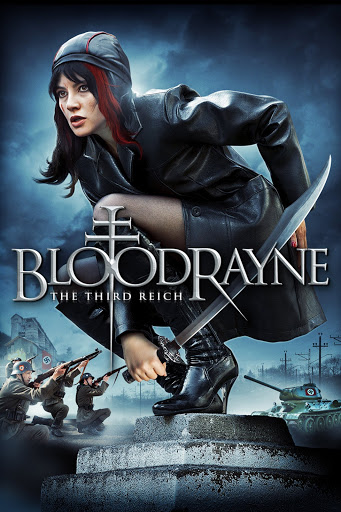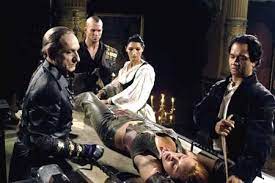PHENOMENALITY: *marvelous*
MYTHICITY: *poor*
FRYEAN MYTHOS: *drama*
CAMPBELLIAN FUNCTION: *cosmological, metaphysical*
How to approach the last film of Jerry Warren, the director famed for such sleep-inducing borefests as TEENAGE ZOMBIES and THE INCREDIBLE PETRIFIED WORLD? One might say, as did reviewer Michael Adams, that FRANKENSTEIN ISLAND was sort of a grab-bag of almost every trope Warren ever used in his original films (as well as a few from his paste-up flicks). That's certainly a fair statement, but it doesn't quite capture the lunacy that is ISLAND. After all, the now-celebrated Ed Wood also made his own share of "grab-bag" films in his career, and many of them are just "so dull they're dull."
I should note in passing that I saw some televised version of ISLAND at least thirty years ago, and that I remembered nothing of that experience when I re-screened it. But seeing ISLAND put me in mind of what I wrote of TEENAGE ZOMBIES: that it seemed like Warren had modeled it on some old mad-scientist B-film from the forties, but had executed his take with all the thrills of dripping tapioca.
ZOMBIES took place on an island wherein innocents were menaced by a mad scientist played by actress Katherine Victor, and so does ISLAND-- but even though Victor doesn't act much better than she did in her cinematic debut, Warren finally managed to both write and direct an original film that was not dull. I'm not saying ISLAND is a good film, of course. But I liked that, instead of picking one threadbare concept and running it into the ground as Warren did throughout most of his career, this time he tried the "everything and the kitchen sink" approach-- probably because he hadn't made a film in fifteen years when he came out of retirement, hoping to tap into the video market for low-budget horror. And though he doesn't do a good job with all the jumbled concepts he tosses into the mix, he does at times make some effort to tie the objects in his grab-bag together somewhat.
Four men-- Paul, Curtis, Mark, and Dino-- go ballooning. We never learn much about any of them, except that Paul (Robert Clarke) is a medical doctor of some sort. Their balloon is mysteriously drawn to an isolated island and they crash-land. Before they can think much about escaping, they're distracted by a tribe of maidens in leopard-skin bikinis. The girls seem generally friendly, though they do string one of their members up by her arms and legs for an initiation ritual. While in the island-girls' company the travelers learn that for some reason, any time they mention aloud the name of some place from the world of everyday experience, they get shooting pains up their arms, as if some forbidding deity were saying, "naughty, naughty." Two scruffy sailors show up and offer to escort the castaways to the laboratory of the island's master.
Said master calls herself Sheila Frankenstein (Victor), and she claims to be the great-granddaughter of the original mad scientist. Sheila's also quick to specify that Frankenstein is not her married name, for she's still married to none other than her great-grandfather's assistant, Doctor Van Helsing (as Bram Stoker rolls over in his grave). Though this Van Helsing has nothing to do with the character from DRACULA, the double-centenarian has been kept alive in a somewhat vampiric fashion, thanks to Sheila giving him injections of blood. Some of these transfusions are taken from the bikini-girls, whom Sheila says are the result of crossbreeding between human beings and some unspecified aliens who never appear in the story as such. Other transfusions come from the one sailor that Shelia keeps prisoner, one Jayson (Cameron Mitchell), who continually quotes Poe and claims that he lost a wife named Lenore. Oh, and in order to keep some trope-continuity with TEENAGE ZOMBIES, Shelia also turned some sailors into near-invulnerable zombies. AND-- though Doctor Frankenstein's body is dead, Shelia keeps her grandsire's brain in her lab, and this may be what makes it possible for the good doctor (John Carradine) to manifest his spirit, ramble nonsense, and impart shocks to anyone who dares to mention the outside world.

Understandably, most of the travelers want nothing to do with the Sheila Frankenstein freak-show-- except Doctor Paul, who becomes intrigued with her miracle-making and starts collaborating with her (though later we learn that Sheila drugged him into compliance). The other three guys make some weak attempts to escape the island, but they get distracted easily-- and not just by the hot girls, who conduct rituals like using skulls as smoking-bongs and messing around with spiders and tarantulas. One castaway even gets into a "playful" wrestling-match with one of Sheila's non-zombie guards. Sheila and Doctor Van Helsing hold intense discussions about how to best keep Van Helsing alive. As I recall this is the point when Sheila belatedly mentions that her great-grandfather's creation is still alive, and that to keep the monster quiescent, she keeps him chained underwater.
Eventually Sheila pushes the castaways too far by abducting one of the jungle girls for transfusion purposes. This leads to a whopper of a recognition scene, for while Jayson's on the transfusion bed he sees in the girl an uncanny resemblance to his lost Lenore-- and so informs her that she's actually his daughter, separated from Jayson and the late Lenore lo these seventeen years. (So-- she's NOT one of the alien hybrids?) Then the castaways and the jungle girls invade the lab, and the three guys try to talk Doctor Paul out of his obsession. The Frankenstein Monster gets free of his underwater prison and storms in, waving his arms but only attacking one victim. This engenders a battle between the good guys and Sheila's zombies. One of the less manic scenes shows a jungle girl watch when a tough guy high-kicks a zombie, and then she imitates the move perfectly on a second zombie. The most manic scene of the climax may be when a zombie-guard brandishes a plastic toy trident at one jungle-girl, and she transforms into a fanged vampire-- her alien ancestry showing?-- moments before a guard disintegrates her with a ray-weapon.
The violence peters out and the four travelers escape the island. They bring the military back to Frankenstein Island and find that all the crazy fantasy-creations have disappeared, except for one small token to prove It Was All Real.
In an odd way, the island might owe more to the Doctor Moreau of cinema than to Mary Shelley's monster-maker. The savage jungle-babes may owe something to Moreau's Lota the Panther Woman (not present in the Wells novel), and the commandment not to speak of outsider places bears some resemblance to the injunction Moreau places upon his beast-men, telling them not to revert to their animal origins (even though Warren drops the whole commandment schtick in the picture's latter half). Warren trying to meld all these discordant fantasy-tropes together gives me some nostalgia for all of his B-movie influences, not least because the audience Warren was aiming at probably would have found all of his schticks incredibly old-hat. There are some fine Ed Wood-isms in Warren's script-- one being "there's another brain hidden somewhere"-- though possibly not enough of them to make ISLAND a winner with the "funny schlock" connoisseurs.
As noted before, Katherine Victor's performance isn't anything to write home about, but that may be partly because Warren was just using Sheila Frankenstein as a convenient pivot for all the film's disparate marvels, not as, say, an actual character. Having said that, the ghost of Carradine-Frankenstein seems to be so active in his spiritual state that I judge him to be the "star of the show" despite his more limited screen-time. Still, Katherine Victor supposedly encouraged Warren to try his hand at movie-making one more time. And because ISLAND is so cheerfully delirious, in my book that makes her more important to the history of schlock cinema than any single role she ever essayed.





















